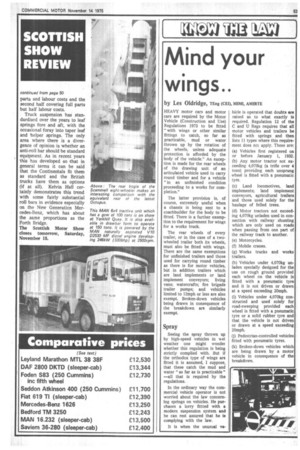Mind your wings..
Page 55

If you've noticed an error in this article please click here to report it so we can fix it.
by Les Oldridge, TEng (CE!) , MIMI, AMIRTE HEAVY motor cars and motor cars are required by the Motor Vehicle (Construction and Use) Regulations 1973 to be fitted " with wings or other similar fittings to catch, so far as practicable, mud or water thrown up by the rotation of the wheels, unless adequate protection is afforded by the body of the vehicle." An exception is made for the rear wheels of the drawing unit of an articulated vehicle used to carry round timber and for a vehicle "in an unfinished condition proceeding to a works for completion."
The latter provision is, of course, extremely useful when a chassis is being sent to a coachbuilder for the body to be fitted. There is a further exemption to the requirement for wings for a works truck.
The rear wheels of every trailer, or in the case of a twowheeled trailer both its wheels, must also be fitted with wings. There are the same exemptions for unfinished trailers and those used for carrying round timber as there is for motor vehicles, but in addition trailers which are land implements or land implement conveyors; living vans; watercrafts; fire brigade trailer pumps; and vehicles limited to 12mph or less are also exempt. Broken-down vehicles being drawn in consequence of the breakdown are similarly exempt.
Spray
Seeing the spray thrown up by high-speed vehicles in wet weather one might wonder whether this regulation is being strictly complied with. But if the orthodox type of wings are fitted it is assumed, I suppose, that these catch the mud and water "as far as is practicable" —all that is required by the regulations.
In the ordinary way the commercial vehicle operator is not worried about the law concerning springs on vehicles. He purchases a lorry fittted with a modern suspension system and he can rest assured that he ia complying with the law.
It is when the unusual ve hide is operated that doubts are raised as to what exactly is required. Regulation 12 of the C and U Regs requires that all motor vehicles and trailers be fitted with springs and then lists 11 types where this requirement does not apply. These are:
(a) Vehicles first registered on or before January 1, 1932.
(b) Any motor tractor not exceeding 4,070kg (a trifle over 4 tons) providing each unsprung wheel is fitted with a pneumatic tyre.
(c) Land locomotives, land implements; land implement conveyors, agricultural trailers and those used solely for the haulage of felled trees.
(d) Motor tractors not exceeding 4,070kg unladen used in connection with railway shunting which are only used on roads when passing from one part of the railway track to another.
(e) Motorcycles.
(f) Mobile cranes.
(g) Works trucks and works trailers.
(h) Vehicles under 4,070kg unladen specially designed for the use on rough ground provided each wheel on the vehicle is fitted with a pneumatic tyre and it is not driven or drawn at a speed exceeding 20mph.
(i) Vehicles under 4,070kg constructed and used solely for road-sweeping provided each wheel is fitted with a pneumatic tyre or a solid rubber tyre and that the vehicle is not driven or drawn at a speed exceeding 20mph.
(j) Pedestrian-controlled vehicles fitted with pneumatic tyres.
(k) Broken-down vehicles which are being drawn by a motor vehicle in consequence of the breakdown.




























































































































